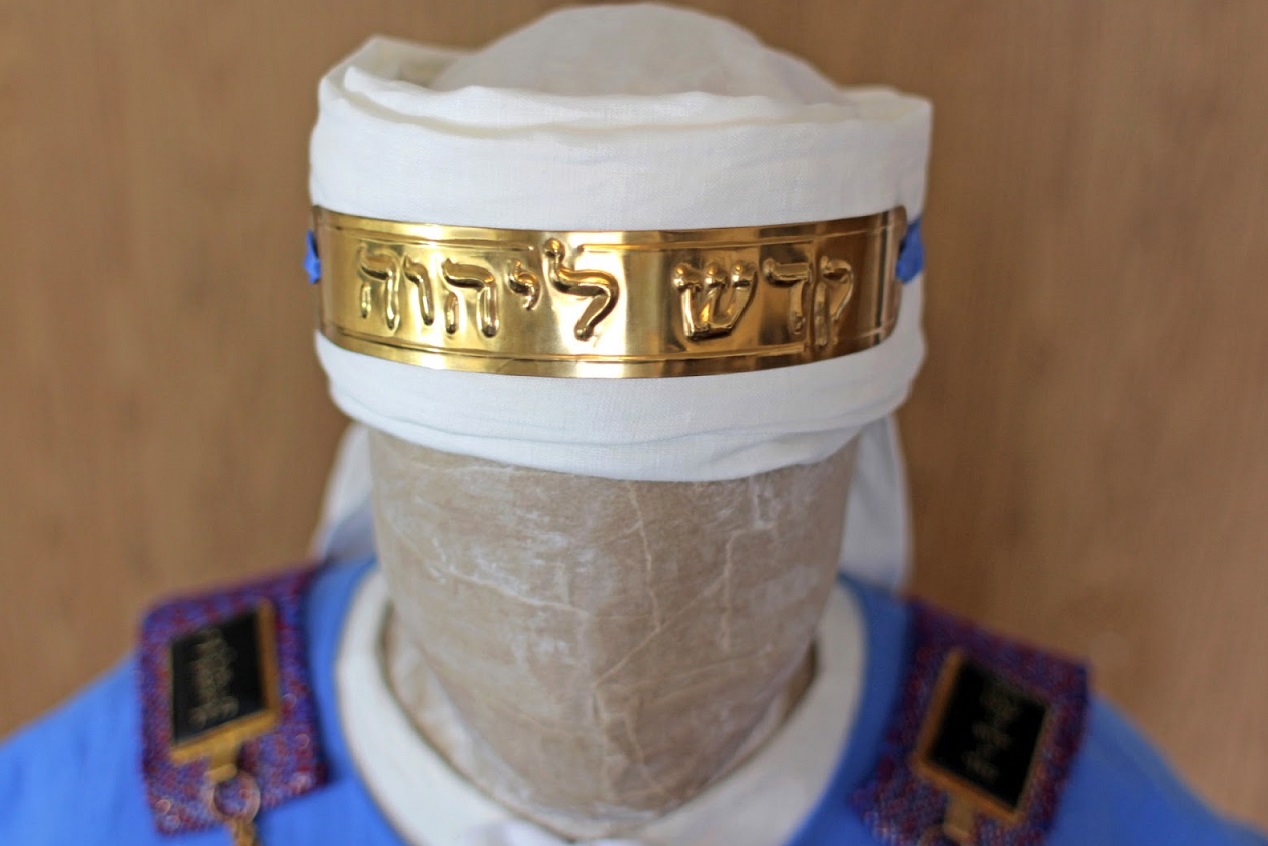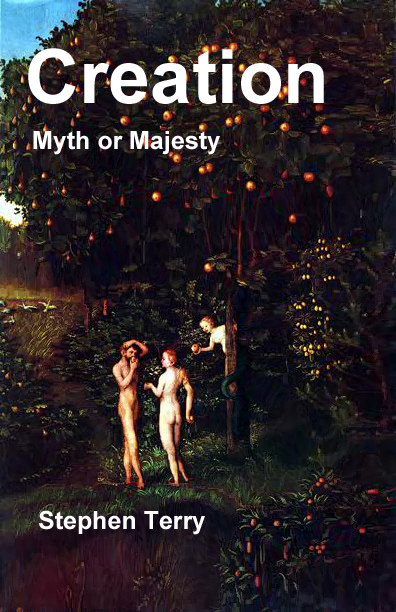
Stephen
Terry, Director

Christ
in the Heavenly Sanctuary
Commentary
for the May 5, 2018 Sabbath School Lesson
 “Make a plate of pure gold and engrave
on it as on a seal: holy to the Lord. Fasten a blue cord to it to attach it to
the turban; it is to be on the front of the turban. It will be on Aaron’s
forehead, and he will bear the guilt involved in the sacred gifts the
Israelites consecrate, whatever their gifts may be. It will be on Aaron’s
forehead continually so that they will be acceptable to the Lord.” Exodus
28:36-38, NIV
“Make a plate of pure gold and engrave
on it as on a seal: holy to the Lord. Fasten a blue cord to it to attach it to
the turban; it is to be on the front of the turban. It will be on Aaron’s
forehead, and he will bear the guilt involved in the sacred gifts the
Israelites consecrate, whatever their gifts may be. It will be on Aaron’s
forehead continually so that they will be acceptable to the Lord.” Exodus
28:36-38, NIV
Per the words of Moses, God established a priestly line
descended from Moses’ brother Aaron who was the first high priest of that
order. They ministered first in the tabernacle before the Ark of the Covenant
and later, beginning in King Solomon’s day, they ministered in the temple.
While initially it was a hereditary office, by the time of Jesus, the high
priesthood was a political plum bestowed for loyalty to the ruler rather than as
a hereditary right.[i]
As a result, political corruption and the high priesthood became synonymous in
the eyes of some. This may have played a role in the Essenes withdrawing from
the Jerusalem community. Nonetheless, the appointees still considered
themselves as members of the Aaronic order, and one of these politically
appointed high priests, Joseph bar Caiaphas, was responsible for pushing for
the execution of Jesus by the Romans. He did not realize, perhaps, that in
doing so, he was actually fulfilling his office as high priest by ordering the offering
of the sacrifice of atonement.
The Aaronic priesthood performed their duties based on
an annual cycle. Daily, animals were brought to the priests. The people would
place their hands on the animals, signifying transference of the sin of the
individual to the animal. Then the priest would slay the animal, demonstrating
the result of sin, death. The blood of the animal was then collected and
sprinkled on the altar, thereby transferring the sin to the tabernacle or temple.
Annually the temple needed to be cleansed of the accumulated sins of the people,
so on the Day of Atonement, the high priest presented the blood of a goat and
then took the sins of the temple and transferred them to another goat, the
scape goat, and symbolically removing the sins from Israel, he had the goat
taken to the wilderness and set free. Every year, thousands of animals died as
this cycle was repeated over and over again. But it was only a metaphor for the
sacrifices had no power to remove sins.[ii] The Aaronic priesthood was
only a symbol of the true priesthood that existed before Aaron and will exist
for all eternity.
Abraham encountered that true priesthood when he was returning
from rescuing his nephew, Lot, from the four kings who attacked Sodom and
looted it.[iii] The Bible tells us that
Melchizedek, King of Salem and Priest of God Most High, came out to meet him
with bread and wine. There are several identifiers here that provide clues to
this unique individual’s identity. His proper name, Melchizedek, means “King of
Righteousness.” His title, King of Salem, means “King of Peace.” He comes
offering the Eucharistic bread and wine representing the only sacrifice he
offers, the body and blood of Christ. Melchizedek is the eternal high priest,
Jesus Christ. While the Aaronic priesthood could not expiate sins with their
continuously offered animals, they pointed toward a better priesthood that
already existed and to which many others would be ordained once the atoning
sacrifice took place on Calvary. Unlike Aaron, who was no ruler, this better
priesthood was a royal one for Melchizedek was not only priest but king. Later,
those who would be ordained to this priesthood would be referred to as royal
priests in recognition of that better calling.[iv]
So if the Aaronic priesthood and temple were ineffective
for dealing with sin, why were they established at all? First of all, the
Aaronic order was a type that pointed to the antitypical Melchizedekian order
and the temple was also a type that pointed to the heavenly antitype.[v] However, lest we fall into
the same trap as those who make God over into their idea of what He should be,
we must be careful about assuming that the heavenly antitype is a literal reproduction
of what was built here on earth. In fact, the Bible tells us that what exists
in heaven is far superior to what we may have had here.[vi] The earthly temple was
little more than a shadow compared to heaven. True, Moses built it according to
a pattern he was shown, but that does not mean the pattern was based on a
structure in heaven. It may simply have been presented by God as a rudimentary
aid to understanding Christ’s ministry as high priest, a ministry that
encompasses far more than simply standing in a room in front of an altar. So
much is beyond our understanding. We even fall short in understanding prayer.
The Holy Spirit has to intercede to make up for our lack of understanding
through wordless groans that are also incomprehensible to us.[vii] If we fail to comprehend
this which should be our daily activity, how much more so what may be taking
place remotely in heaven? Some, who refuse to accept the idea that God would
ever communicate in any manner but literally, would have us believe that Jesus
is standing in heaven, wearing the garments the Aaronic high priest wore and
sprinkling His blood on the same altar as Aaron, only in heaven. They believe
that we are now in an anti-typical literal Day of Atonement that began in the
19th century and continues to the present.
This belief arose as a result of the Great Disappointment.
William Miller, based on calculations from dates and times derived from the
Book of Daniel, believed that Jesus was coming in 1844. When that didn’t
happen, rather than question the calculations, his followers sought around for
an alternate event foretold by Daniel’s timeline. Hiram Edson proposed that it
referred to Christ moving from the Holy Place of the temple to the Most Holy
Place, which occurred typically on the Day of Atonement in the temple in Jerusalem.
This had the benefit of relieving the disappointment without admitting the
possibility of error. William Miller, though, never accepted this idea. Unfortunately,
as with so many other religious doctrines of so many denominations before them,
once this doctrine was accepted by a group of believers, the concrete began to
set and the iron fences were welded into place to prevent any revisitation of
the subject other than to praise it and spread it about. In time, it became a
test to exclude from fellowship those who might question its validity. Sadly,
this entrenchment prevented a deeper understanding of the Melchizedekian
priesthood that goes far beyond the limited model of the earthly temple.
Perhaps one of the most profound insights is the
realization that this priesthood is eternal.[viii] Jesus doesn’t put it
on, go into some room and then once that atonement thing is done, it’s over.
No, He remains high priest which means His order continues forever as well.
When we are ordained with blood, water, and oil as Aaron was, we become members
of that royal priesthood. That happens when we 1) repent of our sins claiming
the blood of Christ on our behalf, 2) are baptized with the water of ritual
purification, and 3) receive the unction of the Holy Spirit.[ix] Perhaps it is to fulfill
this calling that we are granted eternal life. Since it is an eternal
priesthood, it would be hard to fulfill the duties of that office if we did not
have eternal life. This also illustrates how a literal understanding can limit
the reality of the antitype, for there is nothing in the Aaronic sacrificial
system that even hints at an order of royal priests with eternal life.
What about the royal aspect of the priesthood? Why is
that a necessary part of the service of Melchizedekian priests? To understand,
we have to look at the very beginning and the very end of the Bible. In order
to be a king, one must have a dominion to rule over. When the earth was
created, mankind was given the planet as his dominion.[x] We were created to be
kings from the get go. As God has dominion over His creation, we had dominion
over the planet. In this we were in his image though a lesser one to be sure.
That dominion was usurped by one who managed to get us to transfer our trust
from our liege, God, to him, Satan.[xi] He then became the ruler
of the planet through our acquiescence. Jesus even later refers to him as the “prince
of this world.”[xii]
Our ordination as royal priests then anticipates the restoration of that
dominion. This is indeed what is foretold in Revelation.[xiii] Paul tells us that all
of creation looks forward to that day, for it has been in bondage to an evil
ruler and suffers greatly under that oppressive rule.[xiv] But one day it will come
to an end. I look forward to that restoration. Perhaps you do as well.
